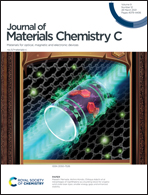Intrinsic lamellar defects containing atomic Cu in Cu2X (X = S, Se) thermoelectric materials†
Abstract
As liquid-like materials, Cu2X (X = S, Se) binary compounds and their solid solutions possess excellent thermoelectric performance but poor stability. Precipitation of copper metal onto the bulk surface under electric or temperature fields is one of the trickiest problems limiting the application of Cu2X (X = S, Se) in thermoelectric devices. Here, high density lamellar defects consisting of close-packed S/Se double layers have been observed in Cu2S, Cu2Se and Cu2S0.5Se0.5. Electron energy-loss spectroscopic analyses in the atomic scale surprisingly found that the copper element shows the characteristic of an atom in the close vicinity of the lamellar defects. Such a configuration should have originated from the small electronegativity discrepancy between copper and sulfur/selenium. The as-observed lamellar defects and atomic copper provide new insight into the investigation of copper precipitation problems. Meanwhile, their formation in high density also suggests their important roles in thermoelectric properties.

- This article is part of the themed collection: Journal of Materials Chemistry C HOT Papers


 Please wait while we load your content...
Please wait while we load your content...